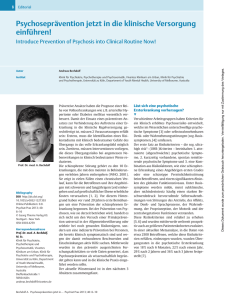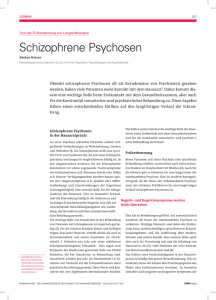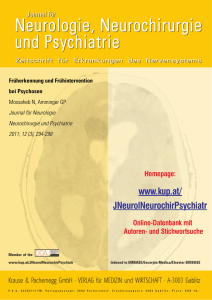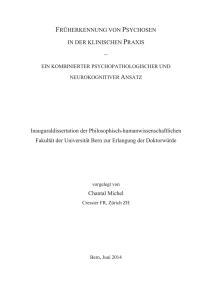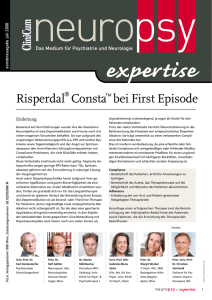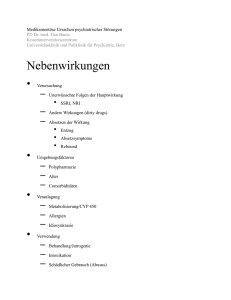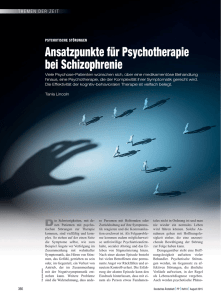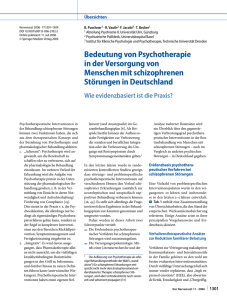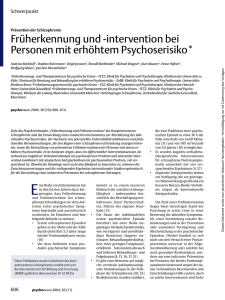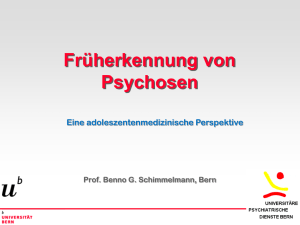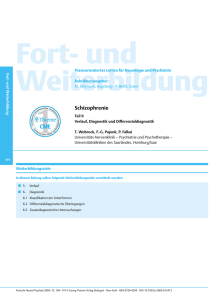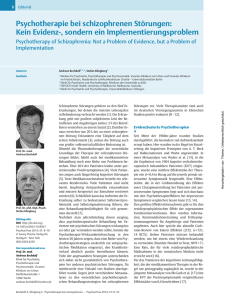Document
Werbung
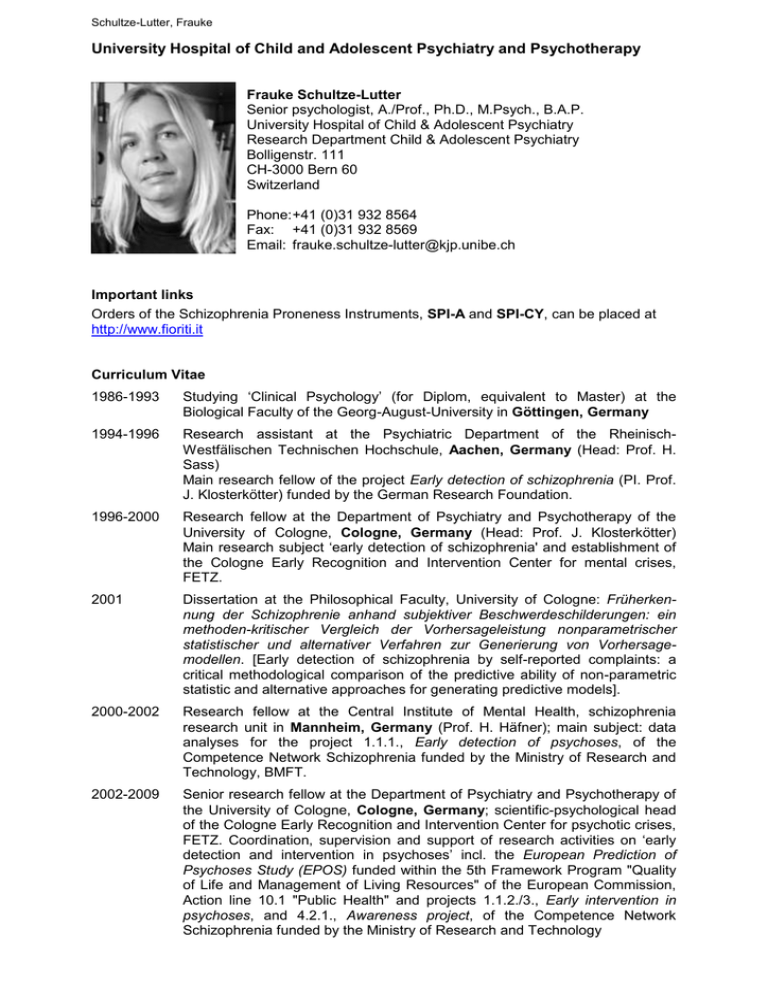
Schultze-Lutter, Frauke University Hospital of Child and Adolescent Psychiatry and Psychotherapy Frauke Schultze-Lutter Senior psychologist, A./Prof., Ph.D., M.Psych., B.A.P. University Hospital of Child & Adolescent Psychiatry Research Department Child & Adolescent Psychiatry Bolligenstr. 111 CH-3000 Bern 60 Switzerland Phone: +41 (0)31 932 8564 Fax: +41 (0)31 932 8569 Email: [email protected] Important links Orders of the Schizophrenia Proneness Instruments, SPI-A and SPI-CY, can be placed at http://www.fioriti.it Curriculum Vitae 1986-1993 Studying ‘Clinical Psychology’ (for Diplom, equivalent to Master) at the Biological Faculty of the Georg-August-University in Göttingen, Germany 1994-1996 Research assistant at the Psychiatric Department of the RheinischWestfälischen Technischen Hochschule, Aachen, Germany (Head: Prof. H. Sass) Main research fellow of the project Early detection of schizophrenia (PI. Prof. J. Klosterkötter) funded by the German Research Foundation. 1996-2000 Research fellow at the Department of Psychiatry and Psychotherapy of the University of Cologne, Cologne, Germany (Head: Prof. J. Klosterkötter) Main research subject ‘early detection of schizophrenia' and establishment of the Cologne Early Recognition and Intervention Center for mental crises, FETZ. 2001 Dissertation at the Philosophical Faculty, University of Cologne: Früherkennung der Schizophrenie anhand subjektiver Beschwerdeschilderungen: ein methoden-kritischer Vergleich der Vorhersageleistung nonparametrischer statistischer und alternativer Verfahren zur Generierung von Vorhersagemodellen. [Early detection of schizophrenia by self-reported complaints: a critical methodological comparison of the predictive ability of non-parametric statistic and alternative approaches for generating predictive models]. 2000-2002 Research fellow at the Central Institute of Mental Health, schizophrenia research unit in Mannheim, Germany (Prof. H. Häfner); main subject: data analyses for the project 1.1.1., Early detection of psychoses, of the Competence Network Schizophrenia funded by the Ministry of Research and Technology, BMFT. 2002-2009 Senior research fellow at the Department of Psychiatry and Psychotherapy of the University of Cologne, Cologne, Germany; scientific-psychological head of the Cologne Early Recognition and Intervention Center for psychotic crises, FETZ. Coordination, supervision and support of research activities on ‘early detection and intervention in psychoses’ incl. the European Prediction of Psychoses Study (EPOS) funded within the 5th Framework Program "Quality of Life and Management of Living Resources" of the European Commission, Action line 10.1 "Public Health" and projects 1.1.2./3., Early intervention in psychoses, and 4.2.1., Awareness project, of the Competence Network Schizophrenia funded by the Ministry of Research and Technology Schultze-Lutter, Frauke Representing the Psychiatric Department in the Zentrum für Versorgungsforschung Köln (ZVFK; Cologne Centre of Health Services Research) Teaching of medical and psychological students, supervision of master and doctoral theses in Psychology and Medicine. 2004 Bachelor of Animal Psychology, Open University of Veterinary Science, London, UK. 2009-2013 Senior research fellow at the University Hospital of Child and Adolescent Psychiatry, Bern, Switzerland; main subject ‘early detection of psychoses’. Establishment and psychological-scientific management of the Früherkennungs- und Therapiezentrum für psychische Krisen Bern (FETZ Bern; http://www.be.ch/fetz), a center for the early detection and intervention in psychoses, in cooperation with the University Hospital of Psychiatry and the Soteria Bern. Supervision of master and doctoral theses in Psychology and Medicine. 2011 Visiting Professor at the Sapienza University of Rome, Department of Neurology and Psychiatry, PhD course ‘Psichiatria: interventi precoci nelle psicosi’, on the methods of designing and analyzing studies. 2013 Receiving the Venia Docendi in Child and Adolescent Psychiatry at the Medical Faculty of the University of Bern. since 2013 Assistant Professor at the University Hospital of Child and Adolescent Psychiatry and Psychotherapy, Bern, Switzerland, and vice-head of its research department. Psychological-scientific management of FETZ Bern. Main Research Interests Early detection and intervention in psychosis and severe affective disorders Early-onset psychosis Epidemiology, psychopathology, help-seeking, stigma & mental health literacy Psychopathology, attenuated and subjective phenomena Research Funding (1) Project funding by the German Research Foundation (June 2000 to December 2003) Prediction of Schizophrenia: Development and Evaluation of an instrument for the prediction of schizophrenic psychosis by basic symptoms. (Own role: Co-Primary Investigator) (2) Stanley Foundation Research Award 2000 of the National Alliance for the Mentally Ill Research Institute (June 2000 to June 2002) for Evaluation of the antipsychotic efficacy of the cannabinoid-antagonistic cannabidiol in treating acute schizophrenic psychosis. A double-blind, controlled clinical trial. (Own role: Co-Investigator) (3) Project funding by Koeln Fortune Program / Faculty of Medicine, University of Cologne (April 2005 to October 2007) Predictive accuracy of criteria for inclusion into prodromal studies in the clientele of the Cologne Early Recognition Centre, FETZ. (Own role: Primary Investigator) (4) Project funding by the German Federal Ministry of Education and Health (July 2006 to June 2009) Development and Implementation of an Early Detection and Intervention Programme for Persons At-Risk for Psychosis. (Own role: Co-Primary Investigator) (5) Project funding by the Swiss National Science Foundation (start 09/2011, funding period: 24 months) Prevalence and burden of at-risk criteria of psychosis and helpseeking behaviour – a population survey. (Own role: Primary Investigator; http://p3.snf.ch/project-135381) (6) Project funding by the Swiss National Science Foundation (lead) and German Research Foundation (start: 09/2013; funding period: 36 months) Early detection of psychosis in Schultze-Lutter, Frauke children and adolescents: An evaluation of current at-risk criteria. (Own role: Co-Primary Investigator; http://p3.snf.ch/project-144100) Awards (1) Gerd Huber-Award for Research on the Prevention of Psychoses; Bonn, Germany, 2010 (2) Poster award at the 7th International Conference on Early Psychosis; Amsterdam, The Netherlands, November 29th – December 1st, 2010 (3) 1st Poster award at the XXXIII. DGKJP Kongress; Rostock, Germany, March 6th – 9th, 2013 (4) 1st Poster award at the SGKJPP & SGPP Jahreskongress; Montreaux, Switzerland, September 11th – 13th, 2013 Professional Memberships International Early Psychosis Association (IEPA; elected ordinary board member 20112014) Swiss Early Psychosis Project (SWEPP; elected board member since 2011) Schizophrenia International Research Society (SIRS) International Society for Psychological and Social Approaches to Psychosis (ISPS) Journal Activities Editorial board: ‘Clinical Neuropsychiatry’ and ‘Psychosis’. Ad hoc referee: ‘Acta Psychiatrica Scandinavica’, ‘Australian and New Zealand Journal of Psychiatry’, ‘British Journal of Psychiatry’, ‘Clinical Neuropsychiatry’, ‘Cognitive Neuropsychiatry’, ‘Diagnostica’, ‘Early Intervention in Psychiatry’, ‘European Psychiatry’, ‘Fortschritte der Neurologie, Psychiatrie’, ‘Journal of Abnormal Child Psychology’, ‘Journal of Child Psychology and Psychiatry’, ‘Nordic Journal of Psychiatry’, ‘Psychiatrische Praxis’, ‘Psychological Medicine’, ‘Psychology and Psychotherapy: Theory, Research and Practice’, ‘Psychopharmacopsychiatry’, ‘Psychopathology’, ‘Psychosis’, ‘Schizophrenia Bulletin’ and ‘Schizophrenia Research’ as well as for the Canadian Institute of Health Research, the Catalan Agency for Health Technology Assessment and Research (CAHTA), the Medical Research Council, UK, and the Netherlands Organization for Health Research and Development (ZonMW). Publications Originalia (* indicates co-first authorship) 1995 (1) Schultze-Lutter F, Klosterkötter J (1995). Do basic symptoms provide a possible explanation for the elevated risk for schizophrenia among mentally retarded? Neurology, Psychiatry and Brain Research, 3: 29-34 1996 (2) Klosterkötter J, Ebel H, Schultze-Lutter F, Steinmeyer EM (1996). Diagnostic validity of basic symptoms. European Archives of Psychiatry and Clinical Neuroscience, 246: 147-154 1997 (3) Klosterkötter J, Schultze-Lutter F, Gross G, Huber H, Steinmeyer EM (1997). Early self-experienced neuropsychological deficits and subsequent schizophrenic diseases: an 8-year average follow-up prospective study. Acta Psychiatrica Scandinavica, 95: 396-404 (4) Klosterkötter J, Gross G, Huber G, Wieneke A, Steinmeyer EM, Schultze-Lutter F (1997). Evaluation of the ‘Bonn Scale for the Assessment of Basic Symptoms BSABS’ as an instrument for the assessment of schizophrenia proneness: A review of recent findings. Neurology, Psychiatry and Brain Research, 5: 137-150 1998 (5) Albers M, Schultze-Lutter F, Steinmeyer EM, Klosterkötter J (1998). Can selfexperienced neuropsychological deficits indicate propensity to schizophrenic Schultze-Lutter, Frauke psychosis? Results of an 8-year prospective follow-up study. International Clinical Psychopharmacology, 13(suppl.1): S75-S80 (6) Bechdolf A, Halve S, Schultze-Lutter F, Klosterkötter J (1998). Selbst wahrnehmbare Vulnerabilität, Prodromalsymptome und Bewältigungsreaktionen vor schizophrenen und affektiven Episoden. Fortschritte in der Neurologie und Psychiatrie, 66: 378-386 2000 (7) Klosterkötter J, Hellmich M, Schultze-Lutter F (2000). Ist die Diagnose schizophrener Störungen schon in der initialen Prodromalphase vor der psychotischen Erstmanifestation möglich? Fortschritte der Neurologie, Psychiatrie, 68(S1): 13-21 2001 (8) Klosterkötter J, Hellmich M, Steinmeyer EM, Schultze-Lutter F (2001). Diagnosing schizophrenia in the initial prodromal phase. Archives of General Psychiatry, 58: 158-164 (9) Klosterkötter J, Schultze-Lutter F (2001). Gibt es eine Primärprävention schizophrener Psychosen? Fortschritte der Neurologie, Psychiatrie, 69(S2): 104-112 2002 (10) Bechdolf A, Schultze-Lutter F, Klosterkötter J (2002) Self-experienced vulnerability, prodromal symptoms and coping strategies preceding schizophrenic and depressive relapses. European Psychiatry, 17: 384-393 2003 (11) Häfner H, Maurer K, Löffler W, an der Heiden W, Hambrecht M, SchultzeLutter F (2003). Modeling the early course of schizophrenia. Schizophrenia Bulletin, 29(2): 325-340 (12) Ruhrmann S, Schultze-Lutter F, Klosterkötter J (2003). Early Detection and Intervention in the Initial Prodromal Phase of Schizophrenia. Pharmacopsychiatry, 36(Suppl 3): 162-167 2004 (13) Köhn D, Niedersteberg A, Wieneke A, Bechdolf A, Pukrop R, Ruhrmann S, Schultze-Lutter F, Maier W, Klosterkötter J (2004). Frühverlauf schizophrener Ersterkrankungen mit langer Dauer der unbehandelten Erkrankung – eine vergleichende Studie. Fortschritte der Neurologie, Psychiatrie, 72: 88-92 (14) Köhn D, Pukrop R, Niedersteberg A, Schultze-Lutter F, Ruhrmann S, Bechdolf A, Berning J, Maier W, Klosterkötter J (2004). Wege in die Behandlung: Hilfesuchverhalten schizophrener Ersterkrankter. Fortschritte der Neurologie, Psychiatrie, 72: 635-642 2005 (15) Bechdolf A, Pukrop R, Köhn D, Tschinkel S, Veith V, Schultze-Lutter F, Ruhrmann S, Geyer C, Pohlmann B, Klosterkötter J (2005). Subjective quality of life in subjects at risk for a first episode of psychosis: a comparison with first episode schizophrenia patients and healthy controls. Schizophrenia Research, 79(1): 137-143 (16) Bechdolf A, Ruhrmann S, Wagner M, Kuhn KU, Janssen B, Bottlender R, Wieneke A, Schultze-Lutter F, Maier W, Klosterkötter J (2005). Interventions in the initial prodromal states of psychosis in Germany: concept and recruitment. British Journal of Psychiatry, 48(suppl.): s45-s48 (17) Brockhaus-Dumke A, Tendolka I, Pukrop R, Schultze-Lutter F, Klosterkötter J, Ruhrmann S (2005). Impaired mismatch negativity generation in prodromal subjects and patients with schizophrenia. Schizophrenia Research, 73: 297-310 (18) Klosterkötter J, Ruhrmann S, Schultze-Lutter F, Salokangas RKR, Linszen D, Birchwood M, Juckel G, Morrison AP, Vázquèz-Barquero JL, Hambrecht M, Graf von Reventlow H, the EPOS group (2005). The European Prediction of Psychosis Study (EPOS): integrating early recognition and intervention in Europe. World Psychiatry, 4(3): 161-167 2006 (19) Koethe D, Gerth CW, Neatby MA, Haensel A, Thies M, Schneider U, Emrich HM, Klosterkötter J, Schultze-Lutter F, Leweke FM (2006). Disturbances of visual information processing in early states of psychosis and experimental delta-9Tetrahydrocannabinol altered states of consciousness. Schizophrenia Research, 88: 142-150 (20) Pukrop R, Schultze-Lutter F, Ruhrmann S, Brockhaus-Dumke A, Tendolkar I, Bechdolf A, Matuschek E, Klosterkötter J (2006). Neurocognitive functioning in Schultze-Lutter, Frauke subjects at risk for a first episode of psychosis compared with first and multiple episode schizophrenia. Journal of Clinical and Experimental Neuropsychology, 28: 1388-1407 2007 (21) Gouzoulis-Mayfrank E, Balke M, Hajsamou S, Ruhrmann S, Schultze-Lutter F, Daumann J, Heekeren K (2007). Orienting of attention in unmedicated patients with schizophrenia, prodromal subjects and healthy relatives. Schizophrenia Research, 97(1-3): 35-42 (22) Huang TJ, Leweke FM, Tsang TM, Koethe D, Kranaster L, Gerth CW, Gross S, Schreiber D, Ruhrmann S, Schultze-Lutter F, Klosterkötter J, Holmes E, Bahn S (2007). CSF metabolic and proteomic profiles in patients prodromal for psychosis. PLoS ONE, 2 (8): e756. doi:10.1371/ journal.pone.0000756 (23) Pukrop R, Ruhrmann S, Schultze-Lutter F, Bechdolf A, Brockhaus-Dumke A, Klosterkötter J (2007). Neurocognitive indicators for a conversion to psychosis: Comparison of patients in a potentially prodromal state who did or did not convert to a psychosis. Schizophrenia Research, 92(1-2): 116-125 (24) Ruhrmann S, Bechdolf A, Kühn KU, Wagner M, Schultze-Lutter F, Janssen B, Maurer K, Häfner H, Gaebel W, Möller HJ, Maier W, Klosterkötter J on behalf of the LIPS study group (2007). Acute effects of treatment for prodromal symptoms for people putatively in a late initial prodromal state of psychosis. British Journal of Psychiatry, 191(suppl.51): s88-s95 (25) Schultze-Lutter F, Klosterkötter J, Picker H, Steinmeyer EM, Ruhrmann S (2007). Predicting First-Episode Psychosis by Basic Symptom Criteria. Clinical Neuropsychiatry, 4(1): 11-22 (free download at http://www.clinicalneuropsychiatry.org) (26) Schultze-Lutter F, Ruhrmann S, Hoyer C, Klosterkötter J, Leweke FM (2007). The initial prodrome of schizophrenia: different duration - different underlying deficits? Comprehensive Psychiatry, 48: 479-488 (27) Schultze-Lutter F, Ruhrmann S, Picker H, Graf von Reventlow H, BrockhausDumke A, Klosterkötter J (2007). Basic symptoms in early psychotic and depressive disorders. British Journal of Psychiatry, 191(suppl.51): s31-s37 (28) Schultze-Lutter F, Ruhrmann S, Picker H, Graf von Reventlow H, Daumann B, Brockhaus-Dumke A, Klosterkötter J, Pukrop R (2007). Relationship between subjective and objective cognitive function in the early and late prodrome. British Journal of Psychiatry, 191(suppl.51): s43-s51 2008 (29) Brockhaus-Dumke A, Schultze-Lutter F, Müller R, Tendolkar I, Bechdolf A, Pukrop R, Klosterkötter J, Ruhrmann S (2008). Sensory gating in schizophrenia: P50 and N100 gating in antipsychotic-free subjects at risk, first-episode and chronic patients. Biological Psychiatry, 64(5): 376-384 (30) Ruhrmann S, Paruch J , Bechdolf A, Pukrop R, Wagner M, Berning J, SchultzeLutter F, Janssen B, Gaebel W, Möller HJ, Maier W, Klosterkötter J (2008). Reduced subjective quality of life in persons at risk for psychosis. Acta Psychiatrica Scandinavica, 117: 357-368 (31) Schultze-Lutter F, Picker H, Ruhrmann S, Klosterkötter J (2008). Das Kölner Früh-Erkennungs- & Therapie-Zentrum für psychische Krisen (FETZ): Evaluation der Inanspruchnahme. Medizinische Klinik, 103 (2): 81-89 (32) Schultze-Lutter F, Steinmeyer EM, Ruhrmann S, Klosterkötter J (2008). The dimensional structure of self-reported 'prodromal' disturbances in schizophrenia. Clinical Neuropsychiatry, 5(3): 140-150 (free download at http://www.clinicalneuropsychiatry.org) 2009 (33) Koethe D, Giuffrida A, Schreiber D, Hellmich M, Schultze-Lutter F, Ruhrmann S, Klosterkötter J, Piomelli D, Leweke FM (2009). Anandamide elevation in cerebrospinal fluid in initial prodromal states of psychosis. British Journal of Psychiatry, 194(4): 371-372 (34) Koethe D, Kranaster L, Hoyer C, Gross S, Neatby MA, Schultze-Lutter F, Ruhrmann S, Klosterkötter J, Hellmich M, Leweke FM (2009). Binocular depth Schultze-Lutter, Frauke inversion as a paradigm of reduced visual information processing in prodromal state, antipsychotic-naïve and treated schizophrenia. European Archives of Psychiatry and Clinical Neuroscience, 259(4): 195-202 (35) Schultze-Lutter F, Ruhrmann S, Klosterkötter J (2009). Early detection of psychosis - establishing a service for persons at risk. European Psychiatry, 24: 1-10 2010 (36) Schultze-Lutter F, Ruhrmann S, Berning J, Maier W, Klosterkötter J (2010). Basic symptoms and ultrahigh risk criteria: Symptom development in the initial prodromal state. Schizophrenia Bulletin, 36(1): 182-191 (37) Ruhrmann S, Schultze-Lutter F, Salokangas RKR, Heinimaa M, Linszen D, Dingemans P, Birchwood M, Patterson P, Juckel G, Heinz A, Morrison A, Lewis S, Graf von Reventlow H, Klosterkötter J (2010). Prediction of Psychosis in Adolescents and Young Adults – Results from a Prospective European Multicenter Study (EPOS). Archives of General Psychiatry, 67(3): 241-251 (38) Velthorst E, Nieman D, Linszen D, Becker H, de Haan L, Dingemans PM, Birchwood M, Patterson P, Salokangas RKR, Heinimaa M, Heinz A, Juckel G, Graf von Reventlow H, French P, Stevens H, Schultze-Lutter F, Klosterkötter J, Ruhrmann S (2010). Disability in people clinically at high risk for a psychosis. British Journal of Psychiatry, 197(4): 278-284 2011 (39) Schimmelmann BG, Michel C, Schaffner N, Schultze-Lutter F (2011). What percentage of people in the general population satisfy the current clinical at-criteria of psychosis? Schizophrenia Research, 125: 99-100 (Letter to the editor) (40) Bodatsch M, Ruhrmann S, Wagner M, Müller R, Schultze-Lutter F, Frommann I, Brinkmeyer J, Gaebel W, Maier W, Klosterkötter J, Brockhaus-Dumke A (2011). Pre-diction of Psychosis by Mismatch Negativity. Biological Psychiatry, 69(10): 959966 (41) Schimmelmann BG, Conus P, Cotton SM, Kupferschmid S, Karow A, SchultzeLutter F, McGorry PD, Lambert M (2011). Cannabis use disorder and age at onset of psychosis – A study in first episode patients. Schizophrenia Research, 129(1): 52-56 2012 (42) Dragt S, Nieman DH, Schultze-Lutter F, van der Meer F, Becker H, de Haan L, Dingemans PM, Birchwood M, Patterson P, Salokangas RKR, Heinimaa M, Heinz A, Juckel G, Graf von Reventlow H, French P, Stevens H, Ruhrmann S, Klosterkötter J, Linszen DH; on behalf of the EPOS group. (2012). Cannabis use and age at onset of symptoms in subjects at clinical high risk for psychosis. Acta Psychiatrica Scandinavica, 125(1): 45-53 (43) Schultze-Lutter F, Klosterkötter J, Michel C, Winkler K, Ruhrmann S (2012). Personality disorders and accentuations in at-risk persons with and without conversion to first-episode psychosis. Early Intervention in Psychiatry, 6: 389-398 (44) Salokangas RKR, Ruhrmann S, Graf von Reventlow H, Heinimaa M, Svirskis T, From T, Luutonen S, Juckel G, Linszen D, Dingemans P, Birchwood M, Patterson P, Schultze-Lutter F, Klosterkötter J, and the EPOS group (2012). Axis I diagnoses and transition to psychosis in clinical high-risk patients. EPOS project: Prospective follow-up of 245 clinical high-risk outpatients in four countries. Schizophrenia Research, 138(2-3):192-197 (45) Schultze-Lutter F*, Schimmelmann BG*, Klosterkötter J, Ruhrmann S (2012) Comparing the prodrome of schizophrenia-spectrum psychoses and affective disorders with and without psychotic features. Schizophrenia Research, 138: 218-222 2013 (46) Nieman DH, Velthorst E, Becker H, de Haan L, Dingemans PM, Linszen D, Birchwood M, Patterson P, Salokangas RKR, Heinimaa M, Heinz A, Juckel G, von Reventlow HG, Morrison A, Schultze-Lutter F, Klosterkötter J, Ruhrmann S, on behalf of the EPOS group (2013). The Strauss and Carpenter Prognostic Scale predicts transition to psychosis in subjects clinically at high risk for psychosis. Acta Psychiatrica Scandinavica, 127(1): 53-61 (47) Salokangas RKR, Nieman DH, Heinimaa M, Svirskis T, Luutonen S, From T, Graf von Reventlow H, Juckel H, Linszen D, Dingemans P, Birchwood M, Patterson P, Schultze-Lutter F, Klosterkötter J, Ruhrmann S and the EPOS group (2013). Schultze-Lutter, Frauke Psychosocial outcome in patients at clinical high risk of psychosis: a prospective follow-up. Social Psychiatry and Psychiatric Epidemiology, 48(2): 303-311 (48) Fux L*, Walger P*, Schimmelmann BG, Schultze-Lutter F (2013). The Schizophrenia Proneness Instrument, Child and Youth version (SPI-CY): practicability and discriminative validity. Schizophrenia Research, 146(1-3): 69-78 (49) Salokangas RKR, Dingemans P, Heinimaa M, Svirskis T, Luutonen S, Hietala J, Ruhrmann S, Juckel G, Graf von Reventlow H, Linszen D, Birchwood M, Patterson P, Schultze-Lutter F, Klosterkötter J and the EPOS group (2013). Prediction of psychosis in clinical high-risk patients by the Schizotypal Personality Questionnaire. Results from the EPOS project. European Psychiatry, 28(8): 469-475 2014 (50) Graf von Reventlow H, Krüger-Özgürdal S, Ruhrmann S, Schultze-Lutter F, Heinz A, Patterson P, Heinimaa M, Dingemans P, French P, Birchwood M, Salokangas RKR, Linszen D, Morrison A, Klosterkötter J, Juckel G (2014). Pathways to care in subjects at high risk for psychotic disorders - a European perspective. Schizophrenia Research, 152(2-3): 400-407 (51) van Tricht MJ*, Ruhrmann S*, Arns M, Müller R, Bodatsch M, Velthorst E, Koelman JHTM, Bour LJ, Zurek K, van der Meer JN, Schultze-Lutter F, Klosterkötter J, Linszen DH, Haan L, Brockhaus-Dumke A, Nieman DH (2014). Can quantitative EEG measures predict clinical outcome in subjects at Clinical High Risk for psychosis? A prospective multicenter study. Schizophrenia Research, 153(1-3): 42-47 (52) Michel C, Schimmelmann BG, Kupferschmid S, Siegwart M, Schultze-Lutter F (2014). Reliability of telephone assessments of at-risk criteria of psychosis: a comparison to face-to-face interviews. Schizophrenia Research, 153(1-3): 251-253 (Letter to the Editors with original data) (53) Schultze-Lutter F, Klosterkötter J, Ruhrmann S (2014). Improving the clinical prediction of psychosis by combining ultra-high risk criteria and cognitive basic symptoms. Schizophrenia Research, 154(1-3): 100-106 (54) Schultze-Lutter F, Renner F, Paruch J, Julkowski D, Klosterkötter J, Ruhrmann S (2014). Self-reported psychotic-like experiences are a poor estimate of clinician-rated attenuated and frank delusions and hallucination. Psychopathology, 47: 194-201 (55) Schmidt SJ, Grunert V, Schimmelmann BG, Schultze-Lutter F, Michel C (2014) Differences in coping, self-efficacy, and external control beliefs between patients atrisk for psychosis and patients with first-episode psychosis. Psychiatry Research, 219(1): 95-102 (56) Salokangas RKR, Heinimaa M, From T, Löyttyniemi E, IlonenT, Luutonen S, Hietala J, Svirskis T, Graf von Reventlow H, Juckel G, Linszen D, Dingemans P, Birchwood M, Patterson P, Schultze-Lutter F, Ruhrmann S, Klosterkötter J (2014). Short-term functional outcome and premorbid adjustment in clinical high-risk patients. Results of the EPOS project. European Psychiatry, 29(6): 371-380 in press / doi (57) Schultze-Lutter F, Michel C, Ruhrmann S, Schimmelmann BG (2013). Prevalence of DSM-5 Attenuated Psychosis Syndrome in adolescents and young adults of the general population: the Bern Epidemiological At-Risk (BEAR) study. Schizophrenia Bulletin: doi: 10.1093/schbul/sbt171 (Open Access) (58) Schultze-Lutter F, Klosterkötter J, Nikolaides A, Ruhrmann S (2014). Personality dimensions in subjects symptomatically at-risk of psychosis: pronounced but lacking a characteristic profile. Early Intervention in Psychiatry, doi: 10.1111/eip.12147 (59) Michel C, Ruhrmann S, Schimmelmann BG, Klosterkötter J, Schultze-Lutter F (2014). A stratified model for psychosis prediction in clinical practice. Schizophrenia Bulletin: doi: 10.1093/schbul/sbu025 Reviews (* indicates co-first authorship) 2005 (1) Ruhrmann S, Schultze-Lutter F, Maier W, Klosterkötter J (2005). Pharmacological intervention in the initial prodromal phase of psychosis. European Psychiatry, 20: Schultze-Lutter, Frauke 1-6 2006 (2) Klosterkötter J, Schultze-Lutter F (2006). Early recognition and intervention research of psychiatric diseases. Neurologia Croatica, 55(Suppl.2): 30-36 2007 (3) Yung A, Killackey E, Hetrick SE, Parker AG, Schultze-Lutter F, Klosterkötter J, Purcell R, McGorry PD (2007). The Prevention of Schizophrenia. International Review of Psychiatry, 19(6): 633-646 2008 (4) Schultze-Lutter F, Ruhrmann S, Klosterkötter J (2008). Early detection and early intervention in psychosis in Western Europe. Clinical Neuropsychiatry, 5(6): 303-315 (5) Klosterkötter J*, Schultze-Lutter F*, Ruhrmann S (2008). Kraepelin and psychotic prodromal conditions. European Archives of Psychiatry and Clinical Neuroscience, 258(Suppl. 2): 74-84 2009 (6) Schultze-Lutter F (2009). Subjective symptoms of schizophrenia in research and the clinic: the basic symptom concept. Schizophrenia Bulletin, 35: 5-8 (7) Ruhrmann S, Schultze-Lutter F, Klosterkötter J (2009). Intervention in the at-risk state to prevent transition to psychosis. Current Opinion in Psychiatry, 22(2): 177-183 (8) McGorry PD, Nelson B, Amminger GP, Bechdolf A, Francey SM, Berger G, Riecher-Rössler A, Klosterkötter J, Ruhrmann S, Schultze-Lutter F, Nordentoft M, Hickie I, McGuire P, Berk M, Chen EYH, Keshavan MS, Yung AR (2009). Intervention in Individuals at Ultra High Risk of Psychosis: A Review and Future Directions. Journal of Clinical Psychiatry, 70(9): 1206-1212 2010 (9) Koch E*, Schultze-Lutter F*, Schimmelmann BG, Resch F (2010). On the importance and detection of prodromal symptoms from the perspective of child and adolescent psychiatry. Clinical Neuropsychiatry, 7(2): 38-48 (free download at http://www.clinicalneuropsychiatry.org) (10) Ruhrmann S*, Schultze-Lutter F*, Klosterkötter J (2010). Sub-threshold states of psychosis – a challenge to diagnosis and treatment. Clinical Neuropsychiatry, 7(2): 72-87 (free download at http://www.clinicalneuropsychiatry.org) (11) Ruhrmann S*, Schultze-Lutter F*, Klosterkötter J (2010). Probably at-risk, but certainly ill – advocating the introduction of a psychosis spectrum disorder in DSM-V. Schizophrenia Research, 120(1-3): 23-37 (12) Ruhrmann S, Schultze-Lutter F, Bechdolf A, Klosterkötter J (2010). Intervention in at-risk states for developing psychosis. European Archives of Psychiatry and Clinical Neuroscience, 260(Suppl.2): S90-S94 2011 (13) Schultze-Lutter F, Resch F, Koch E, Schimmelmann BG (2011). Früherkennung von Psychosen bei Kindern und Adoleszenten. Sind entwicklungsbezogene Besonderheiten ausreichend berücksichtigt? Zeitschrift für Kinder- und Jugendpsychiatrie und Psychotherapie, 39(5): 301-312 (14) Klosterkötter J, Schultze-Lutter F, Bechdolf A, Ruhrmann S (2011). Prediction and prevention of schizophrenia: what has been achieved and where to go next? World Psychiatry, 10(3): 165-174 2012 (15) Schultze-Lutter F, Ruhrmann S, Fusar-Poli P, Bechdolf A, Schimmelmann B, Klosterkötter J (2012). Basic symptoms and the prediction of first-episode psychosis. Current Pharmaceutical Design, 18(4): 351-357 (16) Schaffner N, Schimmelmann BG, Niedersteberg A, Schultze-Lutter F (2012). Versorgungswege von erstmanifesten psychotischen Patienten – eine Übersicht internationaler Studien. Fortschritte der Neurologie, Psychiatrie, 80(2): 72-78 (17) Fiori Nastro P, Schimmelmann BG, Gebhardt E, Monducci E, Resch F, Koch E, Schultze-Lutter F (2012). Le sfide per una corretta individuazione precoce delle psicosi nei bambini e negli adolescent. Rivista di psichiatria, 47(2): 116-125 (18) Ruhrmann S, Klosterkötter J, Bodatsch M, Bechdolf A, Nikolaides A, Hilboll D, Schultze-Lutter F (2012). Pharmacological Prevention and Treatment in Clinical AtRisk States for Psychosis. Current Pharmaceutical Design, 18(4): 550-557 Schultze-Lutter, Frauke (19) Ruhrmann S, Klosterkötter J, Bodatsch M, Nikolaides A, Julkowski D, Hilboll D, Schultze-Lutter F (2012). Chances and reisks of predicting psychosis. European Archives of Psychiatry and Clinical Neuroscience, 262(Suppl 2): S85-S90 (20) Bechdolf A, Rateesh A, Wood SW, Tecic T, Conus P, Nelson B, Cotton SM, Chanen A, Amminger GP, Ruhrmann S, Schultze-Lutter F, Klosterkötter J, FusarPoli P, Yung AR, Berk M, McGorry PD (2012). Rationale and first results of developing at-risk (prodromal) criteria for bipolar disorder. Current Pharmaceutical Design, 18(4): 358-375 2013 (21) Schultze-Lutter F, Ruhrmann S, Schimmelmann BG, Michel C (2013). „A rose is a rose is a rose“, but at-risk criteria differ. Psychopathology, 46: 75-87 (22) Schimmelmann BG, Walger P, Schultze-Lutter F (2013). Significance of prodromal symptoms of schizophrenia in childhood and adolescence. Canadian Journal of Psychiatry, 58(1): 32-40 (23) Fusar-Poli P, Borgwardt S, Bechdolf A, Addington J, Riecher-Rössler A, Schultze-Lutter F, Keshavan M, Wood SJ, Ruhrmann S, Seidman LJ, Valmaggia L, Cannon T, Velthorst E, De Haan L, Cornblatt B, Bonoldi I, Birchwood M, McGlashan TH, Carpenter W, McGorry P, Klosterkötter J, McGuire P, Yung AR (2013). The psychosis high risk state: A comprehensive state-of-the-art review. JAMA Psychiatry, 70(1): 107-120 2014 (24) Schultze-Lutter F, Schimmelmann BG (2014). Psychotische Störungen im DSM-5: die Revisionen. Zeitschrift für Kinder- und Jugendpsychiatrie und Psychotherapie, 42(3): 193-202 in press (25) Schultze-Lutter F, Schimmelmann BG (2014). Early detection and treatment of psychosis – the Bern child and adolescent psychiatric perspective. Advances in Psychiatry, xx: accepted, in press Comments / Editorials (not part of an editored special issue) 2011 (1) Schultze-Lutter F, Schimmelmann BG, Ruhrmann S (2011). The Near Babylonian Speech Confusion in Early Detection of Psychosis. Schizophrenia Bulletin, 37(4): 653-655 (Editorial) 2012 (2) Schimmelmann BG, Schultze-Lutter F (2012). Early detection and intervention of psychosis in children and adolescents: urgent need for studies. European Child & Adolescent Psychiatry, 21(5): 239-241 (Editorial) (3) Yung AR, Woods SW, Ruhrmann S, Addington J, Schultze-Lutter F, Cornblatt BA, Amminger GP, Bechdolf A, Birchwood M, Borgwardt S, Cannon TD, de Haan L, French P, Fusar-Poli P, Keshavan M, Klosterkötter J, Kwon JS, McGorry PD, McGuire P, Mizuno M, Morrison AP, Riecher-Rössler A, Salokangas RK, Seidman LJ, Suzuki M, Valmaggia L, van der Gaag M, Wood SJ, McGlashan TH (2012). Whither the attenuated psychosis syndrome? Schizophrenia Bulletin, 38(6): 1130-1134 (Comment) 2013 (4) Schultze-Lutter F (2013). Förderung der seelischen Gesundheit im Kinder- und Jugendalter. Schweizer Zeitschrift für Psychiatrie & Neurologie, 2: 1 (Editorial) 2014 (5) Michel C, Schultze-Lutter F, Schimmelmann BG (2014). Screening instruments in child and adolescent psychiatry: general and methodological considerations. European Child & Adolescent Psychiatry, doi:10.1007/s00787-014-0608-x (Editorial) Special journal issues, editored 2008 (1) Grispini A, Schultze-Lutter F (eds.) (2008). Early detection and intervention around the world. Clinical Neuropsychiatry 5(6) (free download at http://www.clinicalneuropsychiatry.org) 2010 (2) Grispini A, Schultze-Lutter F (eds.) (2010). Current prodromal criteria of psychosis: prodromal condition or a psychosis-spectrum disorder? Clinical Neuropsychiatry 7(2) (free download at http://www.clinicalneuropsychiatry.org) Schultze-Lutter, Frauke Journal Publications (not peer-reviewed) 1997 (1) Schultze-Lutter F, Hambrecht M, Klosterkötter J (1997). Sind schizophrene Erkrankungen vorhersagbar? Forschung in Köln, 1: 32-38 2000 (2) Schultze-Lutter F, Bechdolf A, Wieneke A (2000). Auf dem Weg in eine schizophrene Psychose? MMW - Fortschritte der Medizin, 10: 32-33 (3) Wieneke A, Bechdolf A, Schultze-Lutter F (2000). Früherkennung bei erhöhtem Risiko für schizophrene Erkrankungen. MMW - Fortschritte der Medizin, 10: 30-32 2002 (4) Schultze-Lutter F, Wieneke A, Klosterkötter J (2002). Diagnostik und Therapie der Schizophrenie. Früherkennung als Ziel. Der Neurologe & Psychiater, 6: 35-41 (5) Schultze-Lutter F, Hellmich M, Steinmeyer EM, Klosterkötter J (2002). Towards a diagnosis of schizophrenia in the initial prodromal phase. Compendium Series: Psychosis & Schizophrenia, 3: 19-21 2003 (6) Ruhrmann S, Schultze-Lutter F, Klosterkötter J (2003). Schizophrenie früh erkennen. Der Hausarzt stellt die Weichen! Der Allgemeinarzt, 17: 294-299 2004 (7) Juckel G, Schultze-Lutter F, Ruhrmann S (2004). Früherkennung beginnender schizophrener Erkrankungen. psychoneuro, 3: 153-159 (8) Klosterkötter J, Ruhrmann S, Schultze-Lutter F (2004). Pharmakologische und psychologische Intervention bei Personen mit erhöhtem Psychoserisiko: Erste Ergebnisse kontrollierter Studien. SCHIZOPHRENIE – Mitteilungsorgan der gfts, 20: 5-14 2005 (9) Juckel G, Schultze-Lutter F, Ruhrmann S, Heinz A, Klosterkötter J (2005). Erfolge auf dem Weg zur Früherkennung. Der Neurologe & Psychiater, Themenheft Schizophrenie: 2-4. (10) Schultze-Lutter F, Ruhrmann S, Klosterkötter J (2005). Erfassung initialer Prodromalsymptome. Neuropsychiatrische Nachrichten, 2: 10 (11) Schultze-Lutter F, Ruhrmann S, Klosterkötter J (2005). Früherkennung schizophrener Störungen. Positive Auswirkungen auf den Krankheitsverlauf und die soziale Integration. extracta psychiatrica/neurologica, 1/2: 16-19 2007 (12) Schultze-Lutter F, Ruhrmann S, Klosterkötter J (2007). Früherkennung und Frühintervention in der Prodromalphase. Neuro-Psychiatrische Zeitung November 2007: 11 2008 (13) Schultze-Lutter F, Ruhrmann S, Klosterkötter J (2008). Präventionsansätze in der Psychiatrie. neuro aktuell 5-08: 21-26 2009 (14) Ruhrmann S, Schultze-Lutter F, Paruch J, Klosterkötter J (2009). Prädiktion und Prävention psychischer Störungen am Beispiel der Psychosen. Die Psychiatrie, 6(4): 213-220 2011 (15) Resch F, Koch E, Schultze-Lutter F, Schimmelmann BG (2011). Schizophrene Psychosen des Kindes- und Jugendalters. Psychiatrie und Psychotherapie up2date, 5(2): 85-98 2012 (16) Schimmelmann BG, Siegwart M, Kupferschmid S, Schultze-Lutter F (2012). Früherkennung und Frühbehandlung von Psychosen im Kindes- und Jugendalter. Pro Mente Sana - aktuell, 4: 24-25 2013 (17) Schultze-Lutter F, Schimmelmann BG (2013). Früherkennung von Psychosen und bipolaren Störungen bei Kindern und Jugendlichen. Schweizer Zeitschrift für Psychiatrie & Neurologie, 2: 4-8 (18) Schultze-Lutter F, Schimmelmann BG (2013). Frühe Anzeichen einer Psychose. Welche Kriterien sprechen bei Kindern und Jugendlichen für Psychosen und bipolare Störungen? ARS MEDICI, 20: 1020-1024 Schultze-Lutter, Frauke 2014 (19) Schultze-Lutter F (2014). Früherkennung von Psychosen vor deren Erstmanifestation: Chance oder Sackgasse? Kerbe. Forum für soziale Psychiatrie, 3: 36-39 Book Chapters 2001 (1) Schultze-Lutter F, Wieneke A, Klosterkötter J (2001). Basissymptome - ein Konzept zur Erfassung schizophrener Vulnerabilität und Schizotypie? In: Andresen B, Maß R (Hrsg.). Schizotypie. Psychometrische Entwicklungen und biopsychologische Forschungsansätze. Göttingen; Hogrefe-Verlag: S. 273-298 2002 (2) Schultze-Lutter F, Löffler W, Häfner H (2002). Testing models of the early course of schizophrenia. In: Häfner H (ed.). Risk and protective factors in schizophrenia – towards a conceptual model of the disease process. Darmstadt; Steinkopf-Verlag: S. 229-241 2003 (3) Klosterkötter J, Schultze-Lutter F (2003). Basic symptoms in the early detection and intervention in schizophrenic disorders. In: Grispini A (ed.). Preventive strategies for schizophrenic disorders. Roma, Giovanni Fioriti Editore srl: pp. 269-286 (4) Klosterkötter J, Schultze-Lutter F, Ruhrmann S (2003). Früherkennungssysteme der schizophrenen Erkrankung. In: Falkai P, Pajonk FG (Hrsg.). Psychotische Störungen. Systematische Therapie mit modernen Neuroleptika. Stuttgart, New York; Georg Thieme Verlag: S. 23-35 2004 (5) Ruhrmann S, Schultze-Lutter F, Klosterkötter J (2004). Früherkennung und Frühintervention: Stand der Forschung. In: Fleischhacker WW, Hummer M (Hrsg.). Schizophrene Störungen. State of the art 3. Innsbruck, Verlag Integrative Psychiatrie: S. 31-48 (6) Schultze-Lutter F (2004). Prediction of psychosis is necessary and possible. In: McDonald C, Schultz K, Murray R, Wright P (eds.). Schizophrenia: Challenging the Orthodox. London, New York; Taylor & Francis: pp. 81-90 2005 (7) Ruhrmann S, Birchwood M, Linszen DH, Salokangas RKR, Vázquez-Barquero JL, Schultze-Lutter F, Hambrecht M, Klosterkötter J (2005). El Estudio Europeo de Predicción de la Psicosis (proyecto EPOS): una aproximación integral a la detectión e intervención tempranas en Europa. In: Vázquez-Barquero JL, Crespo Facorro B, Herrán A (eds.). Las fases tempranas de las psicosis. Barcelona; Masson: pp. 167182 (8) Ruhrmann S, Schultze-Lutter F, Klosterkötter J (2005). Programma sobre reconocimiento temprano e intervención de los estados prodrómicos de la psicosis de Colonia. In: Vázquez-Barquero JL, Crespo Facorro B, Herrán A (eds.). Las fases tempranas de las psicosis. Barcelona; Masson: pp. 125-132 (9) Schultze-Lutter F, Klosterkötter J, Ruhrmann S (2005). Factores de predicción psicopatológicos del desarrollo de la psicosis. In: Vázquez-Barquero JL, Crespo Facorro B, Herrán A (eds.). Las fases tempranas de las psicosis. Barcelona; Masson: pp. 39-46 2006 (10) Addington J, Schultze-Lutter F (2006). Prodromal Phase of Psychosis in Adolescent Women. In: Romans S, Seeman MV (eds.). Women's Mental Health: A Life Cycle Approach. Philadelphia, USA; Lippincott Williams & Wilkins: pp. 123-132 (11) Schultze-Lutter F, Ruhrmann S, Klosterkötter J (2006). Can schizophrenia be predicted phenomenologically? In: Johannessen JO, Martindale B, Cullberg J (eds.). Evolving Psychosis. Different Stages, Different Treatments. London, New York; Routledge: pp.104-123 2007 (12) Klosterkötter J, Schultze-Lutter F, Ruhrmann S (2007). Früherkennung und Frühbehandlung der Schizophrenie. In: Hartwich P, Barocka A (Hrsg.). Schizophrene Erkrankungen. Prophylaxe, Diagnostik und Therapie. Sternenfels; Verlag Wissenschaft & Praxis: S. 11-32 2009 (13) Yung A, Klosterkötter J, Cornblatt B, Schultze-Lutter F (2009). At Risk Mental State and Prediction. In: Jackson HJ, McGorry PD (eds.). The Recognition and Schultze-Lutter, Frauke Management of Early Psychosis: A Preventive Approach (2nd edition). Cambridge, UK; Cambridge University Press: pp. 291-372 2010 (14) Klosterkötter J, Schultze-Lutter F (2010). Prevention and early treatment. In: Helmchen H, Sartorius N (eds.). Ethics in Psychiatry – European contributions. Heidelberg; Springer Science+Business Media B.V.: pp. 235-262 2011 (15) Schultze-Lutter F, Michel C, Ruhrmann S, Klosterkötter J, Schimmelmann BG (2011). Prediction and Early Detection of First-Episode Psychosis. In: Ritsner M (ed.). Textbook of Schizophrenia Spectrum Disorders, Volume II. Dordrecht; Springer Science+Business Media B.V.: pp. 207-268 (16) Ruhrmann S, Schultze-Lutter F, Schimmelmann BG, Klosterkötter J (2011). Prevention and early intervention in at-risk states for developing psychosis. In: Ritsner M (ed.). Textbook of Schizophrenia Spectrum Disorders, Volume III. Dordrecht; Springer Science+Business Media B.V.: pp. 81-92 2012 (17) Schultze-Lutter F, Ruhrmann S, Schimmelmann BG (2012). Early detection and treatment of patients symptomatically at-risk for psychosis. In: Lambert M, Naber D (eds.). Current Schizophrenia. Third Edition. London; Springer Healthcare: pp. 6-15 (18) Schultze-Lutter F, Gebhardt E (2012). Sintomi e segni della psicosi schizofrenica: dai prodromi alla remissione. In: Carcione A, Nicolò G, Procacci M (eds.). Manuale di terapia cognitiva delle psicosi. Milano; FrancoAngeli s.r.l.: pp. 4766 2014 (19) Schultze-Lutter F, Schimmelmann BG (2014). Rationalen und Konzepte der Früherkennung von Psychosen. In: Schimmelmann BG, Resch F (Hrsg.). Psychosen in der Adoleszenz. Entwicklungspsychopathologie – Früherkennung – Therapie. Stuttgart; Kohlhammer: 163-178 (20) Schultze-Lutter F (2014). Ethik der Früherkennung von Psychosen. In: Schimmelmann BG, Resch F (Hrsg.). Psychosen in der Adoleszenz. Entwicklungspsychopathologie – Früherkennung – Therapie. Stuttgart; Kohlhammer: 179-184 in press (21) Schultze-Lutter F, Michel C, Schimmelmann BG (in press). Psychosen. In: Rössler W, Ajdacic-Gross V (Hrsg.). Prävention psychischer Störungen. Stuttgart; Kohlhammer: xx-xx Books (incl. translations) 2007 (1) Schultze-Lutter F, Addington J, Ruhrmann S, Klosterkötter J (2007). Schizophrenia Proneness Instrument, Adult version (SPI-A). Roma, Giovanni Fioriti Editore s.r.l. (English version: http://www.fioriti.it) 2008 (2) Schultze-Lutter F, Addington J, Ruhrmann S, Klosterkötter J (2008). Strumento di valutazione per la propensione alla schizofrenia, versione per adulti (SPI-A). Roma, Giovanni Fioriti Editore s.r.l. (Italian version: http://www.fioriti.it) (3) Schultze-Lutter F, Ruhrmann S (2008). Früherkennung und Frühbehandlung von Psychosen. Bremen, Uni-Med Verlag 2010 (4) Schultze-Lutter F, Koch E (2010). Schizophrenia Proneness Instrument, Child and Youth version (SPI-CY). Roma, Giovanni Fioriti Editore s.r.l. (German version: http://www.fioriti.it) (5) Schultze-Lutter F, Koch E (2010). Strumento di valutazione per la propensione alla schizofrenia, versione per bambini e adolescenti. Roma, Giovanni Fioriti Editore s.r.l (Italian version: http://www.fioriti.it) 2011 (6) Schultze-Lutter F, Addington J, Ruhrmann S, Klosterkötter J (2011). Instrumento de Propensão à Esquizofrenia – Versão Adulto (SPI-A). Roma, Giovanni Fioriti Editore s.r.l. (E-book; Portuguese version: http://www.fioriti.it) (7) Schultze-Lutter F, Addington J, Ruhrmann S, Klosterkötter J (2011). ΕΡΓΑΛΕΙΟ ΠΡΟΔΙΑΘΕΣΗΣ ΓΙΑ ΤΗ ΣΧΙΖΟΦΡΕΝΕΙΑ, ΕΚΔΟΧ. Roma, Giovanni Fioriti Editore s.r.l. (E-book; Greek version: http://www.fioriti.it) Schultze-Lutter, Frauke (8) Schultze-Lutter F, Addington J, Ruhrmann S, Klosterkötter J (2011). Outil d’évaluation du risque schizophrénique, Version Adulte (OERS-A). Roma, Giovanni Fioriti Editore s.r.l. (French version: http://www.fioriti.it) 2012 (9) Schultze-Lutter F, Marshall M, Koch E (2012). Schizophrenia Proneness Instrument, Child and Youth version; Extended English Translation (SPI-CY EET). Roma, Giovanni Fioriti Editore s.r.l. (English version: http://www.fioriti.it) (10) Schultze-Lutter F, Addington J, Ruhrmann S, Klosterkötter J (2012). Instrumento de Vulnerabilidad a la Esquizofrenia, Versión para Adultos (SPI-A) Roma, Giovanni Fioriti Editore s.r.l. (E-book; Spanish version: http://www.fioriti.it) (11) Schultze-Lutter F, Addington J, Ruhrmann S, Klosterkötter J (2012). Инструмент по оценке предрасположенности к шизофрении. Взрослая версия (SPI-A). Roma, Giovanni Fioriti Editore s.r.l. (E-book; Russian version: http://www.fioriti.it) 2013 (12) Schultze-Lutter F, Addington J, Ruhrmann S, Klosterkötter J (2013). Schizophrenia Proneness Instrument, Adult version (SPI-A). Roma, Giovanni Fioriti Editore s.r.l. (E-book; Norwegian version: http://www.fioriti.it) Selected Abstracts (first or senior authorship) 1997 (1) Schultze-Lutter F, Steinmeyer EM, Klosterkötter J (1997). Can self-experienced neuropsychological deficits indicate a psychosis proneness? Results of an 8-year average follow-up prospective study. Schizophrenia Research, 24 (1,2): 124 (2) Schultze-Lutter F, Steinmeyer EM, Klosterkötter J (1997). Self-experienced neuropsychological deficits in the mentally retarded as a possible cause of schizophrenia proneness. Schizophrenia Research, 24 (1,2): 124 1998 (3) Klosterkötter J, Schultze-Lutter F (1998). Diagnosing schizophrenia in the prodromal phase. European Psychiatry, 13 (Suppl.4): 144s (4) Steinmeyer EM, Schultze-Lutter F (1998). Facet theoretical analysis oft he similarity relationships of personality factors and personality disorders. European Psychiatry, 13 (Suppl.4): 193s (5) Schultze-Lutter F, Klosterkötter J, Steinmeyer EM (1998). Application of the ‘rough set’ model for the evaluation of self-experienced neuropsychological deficits as predictors for schizophrenia. Results of an 8-year follow-up prospective study. Schizophrenia Research, 29 (1,2): 61-62 (6) Schultze-Lutter F, Steinmeyer EM, Klosterkötter J (1998). Are self-experienced neuropsychological deficits able to predict schizophrenia ? Results of a prospective follow-up study. Schizophrenia Research, 29 (1,2): 62 1999 (7) Schultze-Lutter F, Klosterkötter J (1999). What Tool Should Be Used for Generating Predictive Models? Schizophrenia Research, 36 (1-3): 10 2000 (8) Klosterkötter J, Schultze-Lutter F (2000). Diagnosing schizophrenia in the initial prodromal phase. Schizophrenia Research, 41 (1): 10-11 (9) Klosterkötter J, Schultze-Lutter F (2000). Schizophrenia, its initial prodrome and the Borderline problem. Neurologia Croatica, 49 (Suppl.2): 16 (10) Schultze-Lutter F (2000). Ruling in or ruling out the schizophrenic prodrome: What criteria for symptom selection should be used? Schizophrenia Research, 41 (1): 179 (11) Schultze-Lutter F, Klosterkötter J (2000). Can schizophrenia be predicted phenomenologically? Acta Psychiatrica Scandinavica, 404 (suppl. Vol. 102): 3 (12) Schultze-Lutter F, Klosterkötter J (2000). Assessment of personality traits: Does it support the early detection of psychoses? Acta Psychiatrica Scandinavica, 404 (suppl. Vol. 102): 42 Schultze-Lutter, Frauke 2001 (13) Klosterkötter J, Schultze-Lutter F (2001). Is there a primary prevention of schizophrenic psychosis? Fortschritte der Neurologie, Psychiatrie, 69: 104 (14) Schultze-Lutter F, Wieneke A, Steinmeyer EM, Klosterkötter J (2001). Trait or state-trait markers of schizophrenia. What is what? Schizophrenia Research, 49 (12): 21 2002 (15) Klosterkötter J, Wieneke A, Ruhrmann S, Picker H, Steinmeyer EM, Tendolka I, Pukrop R, Schultze-Lutter F (2002). Predicting psychosis by early self-experienced symptoms. Acta Psychiatrica Scandinavica, 413 (suppl. Vol. 106): 27-28 (16) Schultze-Lutter F (2002). Early detection of psychosis in mentally retarded: particularities. European Psychiatry, 17 (suppl. 1): 154s (17) Schultze-Lutter F (2002). Generating prediction rules: dependence on the mathematical model. European Psychiatry, 17 (suppl. 1): 169s (18) Schultze-Lutter F (2002). On the dependence of variable selection and prediction on the mathematical model. Schizophrenia Research, 53 (3): 37-38 (19) Schultze-Lutter F, Klosterkötter J, Leweke FM, Wieneke A (2002). Duration of the initial prodrome and prediction of schizophrenia. European Psychiatry, 17 (suppl. 1): 179s (20) Schultze-Lutter F, Leweke FM, Klosterkötter J, Wieneke A (2002). Variation in the duration of the initial prodrome: a cognitive psychological approach. Schizophrenia Research, 53 (3): 38 (21) Wieneke A, Schultze-Lutter F (2002). The initial prodrome of schizophrenia: a case report. European Psychiatry, 17 (1 Suppl.): 179s 2004 (22) Ruhrmann S, Schultze-Lutter F (2004). Detection of the initial prodromal phase of psychosis. European Psychiatry, 19 (1 Suppl.): 22-23 (23) Schultze-Lutter F, Ruhrmann S, Picker H, Wieneke A (2004). Symptoms and complaints in „prodromal“ patients. Schizophrenia Research, 70 (1 Suppl.): 36-37 (24) Schultze-Lutter F, Steinmeyer EM, Picker H, Wieneke A, Bühler B, Ruhrmann S, Klosterkötter J (2004). Detecting schizophrenia in the early prodrome. Schizophrenia Research, 67 (1 Suppl.): 19-20 (25) Schultze-Lutter F, Steinmeyer EM, Picker H, Wieneke A, Bühler B, Ruhrmann S, Klosterkötter J (2004). Construct validity of the Schizophrenia Prediction Instrument, Adult version (SPI-A). Schizophrenia Research, 67 (1 Suppl.): 38-39 (26) Schultze-Lutter F, Wieneke A, Picker H, Rolff Y, Steinmeyer EM, Ruhrmann S, Klosterkötter J. (2004). The Schizophrenia Prediction Instrument, Adult version (SPIA). Schizophrenia Research, 70 (1 Suppl.): 76-77 2005 (27) Koethe D, Schultze-Lutter F (2005). The endocannabinoid modulator cannabidiol as an antipsychotic. Pharmacopsychiatry, 38: A125 (28) Schultze-Lutter F, Ruhrmann S, Picker H, Wieneke A, Steinmeyer EM, Klosterkötter J (2005). How ill are persons at risk for psychosis? A comparison with first-episode schizophrenia and non-psychotic affective disorder. European Psychiatry, 20(1 Suppl.): 61 (29) Schultze-Lutter F, Ruhrmann S, Wieneke A, Picker H, Klosterkötter J (2005). Self-experienced cognitive disturbances predict first episode psychosis. Schizophrenia Bulletin, 31 (2): 210 2006 (30) Schultze-Lutter F, Ruhrmann S, Picker H, Klosterkötter J (2006). The Schizophrenia Proneness Instrument (SPI-A) – a tool for the assessment of basic symptoms. European Psychiatry 21 (1 Suppl.): 27 (31) Schultze-Lutter F, Ruhrmann S, Picker H, Klosterkötter J (2006). Development and evaluation of the Schizophrenia Proneness Instrument, Adult version (SPI-A). Schizophrenia Research, 86 (Suppl.): 4-5 Schultze-Lutter, Frauke (32) Schultze-Lutter F, Ruhrmann S, Picker H, Becker I, Von Reventlow HG, Klosterkötter J (2006). Comorbid psychiatric disorders in persons at high risk of psychosis. Schizophrenia Research, 81: 269 (33) Schultze-Lutter F, Ruhrmann S, Picker H, Klosterkötter J (2006). Predicting psychosis: The role of subjective cognitive disturbances. Schizophrenia Research, 81: 270 2007 (34) Klosterkötter J, Ruhrmann S, Schultze-Lutter F (2007). Development of criteria for the early diagnosis of schizophrenic disorders. Nervenarzt, 78: 459-460 (35) Neumann M, Ruhrmann S, Schultze-Lutter F (2007). Impact of locus of control on cannabis abstinence. European Archives of Psychiatry and Clinical Neuroscience, 257 (1 Suppl.): 19 (36) Schultze-Lutter F, Ruhrmann S, Klosterkötter J (2007). Softly, softly catchee monkey - starting an early detection service for persons at risk of psychosis. European Archives of Psychiatry and Clinical Neuroscience, 257 (1 Suppl.): 27-28 (37) Schultze-Lutter F, Ruhrmann S, Picker H, Klosterkötter J (2007). Basic symptoms in the prediction of psychosis. European Archives of Psychiatry and Clinical Neuroscience, 257 (1 Suppl.): 28 (38) Schultze-Lutter F, Ruhrmann S, Veith V, Klosterkotter J (2007). Basic symptoms and UHR criteria: Testing a sequential model of symptom development retrospectively. European Archives of Psychiatry and Clinical Neuroscience, 257 (1 Suppl.): 17 2008 (39) Leweke F. M, Gerth C. W, Nolden B. M, Schreiber D, Schultze-Lutter F, Hellmich M, Klosterkötter J, Koethe D (2008). Cannabidiol as antipsychotic European Neuropsychopharmacology, 18 (4 Suppl.): 171 (40) Schultze-Lutter F, Ruhrmann S, Picker H, Klosterkötter J (2008). What determines 1-year transition in a sample symptomatically at long-term high risk of psychosis? Early Intervention in Psychiatry, 2: A41 (41) Schultze-Lutter F, Ruhrmann S, Niedersteberg A, et al. (2008). Help-seeking in first-episode psychosis: who is the driving force? Early Intervention in Psychiatry, 2: A77 (42) Schultze-Lutter F, Ruhrmann S, Klosterkötter J (2008). Early detection of psychosis: who is reached? Early Intervention in Psychiatry, 2: A134 (43) Schultze-Lutter F, Niedersteberg A, Ruhrmann S, Veith V, Klosterkötter J (2008). Who initiates first help-seeking in first-episode psychosis? Schizophrenia Research, 98 (Suppl.): 93-94 (44) Schultze-Lutter F, Ruhrmann S, Picker H (2008). Basic symptoms and UHR criteria in the prediction of first-episode psychosis. Schizophrenia Research, 102 (1-3 Suppl.): 155-156 (45) Schultze-Lutter F, Ruhrmann S, Picker H, Klosterkötter J (2008). Prediction of first-episode Psychosis: Basic symptom and ultra high risk (UHR) criteria. Schizophrenia Research, 98 (Suppl.): 10 (46) Schultze-Lutter F, Ruhrmann S, Veith V, Klosterkötter J (2008). Basic symptom and ultra high risk (UHR) criteria: Testing a sequential model of symptom development retrospectively. Schizophrenia Research, 98 (Suppl.): 94 2009 (47) Schultze-Lutter F, Ruhrmann S, Klosterkötter J (2009). Symptom development in prodromal first-episode psychosis. Psychosis, 1: 22 (48) Schultze-Lutter F, Ruhrmann S, Klosterkötter J (2009). Prognostic accuracy of at-risk criteria in a help-seeking sample. Psychosis, 1: 36-37 (49) Schultze-Lutter F, Ruhrmann S, Klosterkötter J (2009). Determinants of 1-year transition in a sample symptomatically at long-term high risk of psychosis. Psychosis, 1: 37 Schultze-Lutter, Frauke (50) Schultze-Lutter F, Ruhrmann S, Klosterkötter J (2009). Who is reached by a service fort he early detection of psychosis prior to the first episode? Psychosis, 1: 89-90 (51) Schultze-Lutter F, Ruhrmann S, Niedersteberg A, Klosterkötter J (2009). Who initiates help-seeking in first-episode psychosis? Psychosis, 1: 49-50 (52) Schultze-Lutter F, Winkler K, Klosterkötter J, Ruhrmann S (2009). Persönlichkeitsfaktoren und psychopathologische Frühsymptome. In: Schneider F, Grözinger M (Hrsg.). Psychische Erkrankungen in der Lebensspanne. Abstractbuch zum DGPPN Kongress 2009, 25.-28. November 2009, ICC Berlin. Deutsche Gesellschaft für Psychiatrie, Psychotherapie und Nervenheilkunde e.V.. DOI: 10.3287/dgppn.2009.1: 75 (53) Schultze-Lutter F, Koch E, Resch F (2009). Das Schizophrenia Proneness Instrument, Child and Youth version (SPI-CY). In: Schneider F, Grözinger M (Hrsg.). Psychische Erkrankungen in der Lebensspanne. Abstractbuch zum DGPPN Kongress 2009, 25.-28. November 2009, ICC Berlin. Deutsche Gesellschaft für Psychiatrie, Psychotherapie und Nervenheilkunde e.V.. DOI: 10.3287/dgppn.2009.1: 72 (54) Walger P, Schultze-Lutter F (2009). Identifizierung von adoleszenten Risikogruppen für psychotische Merkmale: Erste Anwendungserfahrungen mit der SPI-CY. In: Schneider F, Grözinger M (Hrsg.). Psychische Erkrankungen in der Lebensspanne. Abstractbuch zum DGPPN Kongress 2009, 25.-28. November 2009, ICC Berlin. Deutsche Gesellschaft für Psychiatrie, Psychotherapie und Nervenheilkunde e.V.. DOI: 10.3287/dgppn.2009.1: 72-73 2010 (55) Michel C, Schimmelmann B G, Schaffner N, Schultze-Lutter F (2010). Prevalence and burden of at-risk criteria of psychosis and held-seeking behaviour – a population survey – attitudes. Schizophrenia Research, 117(2-3 Suppl.): 313 (56) Michel C, Schimmelmann B G, Schaffner N, Schultze-Lutter F (2010). Prevalence and burden of at-risk criteria of psychosis and held-seeking behaviour – a population survey – pathway-to-care. Schizophrenia Research, 117(2-3 Suppl.): 313314 (57) Schultze-Lutter F, Schimmelmann B G, Koch E (2010). The dimensional structure of prodromal symptoms in early-onset psychosis: indication of special needs in the early detection of younger adolescents. Schizophrenia Research, 117(2-3 Suppl.): 321 (58) Schultze-Lutter F, Klosterkötter J, Ruhrmann S (2010). The role of personality disorder and accentuation in the conversion to psychosis. Schizophrenia Research, 117(2-3 Suppl.): 422-423 (59) Schultze-Lutter F, Michel C, Schaffner N, Schimmelmann B G (2010). Prevalence and burden of at-risk criteria of psychosis and held-seeking behaviour – a population survey – prevalence. Schizophrenia Research, 117(2-3 Suppl.): 428-429 (60) Ruhrmann S, Klosterkötter J, Schultze-Lutter F (2010). Basic symptom and ultra-high risk criteria in the prediction of first-episode psychosis. Early Intervention in Psychiatry, 4(Suppl.1): 110 (61) Schultze-Lutter F, Koch E, Resch F, Schimmelmann BG (2010). The dimensional structure of basic symptoms in early-onset psychosis indicates special needs in the early detection of younger adolescents. Early Intervention in Psychiatry, 4(Suppl.1): 109 (62) Schultze-Lutter F, Koch E, Resch F, Schimmelmann BG (2010). The early detection of psychosis from the perspective of child and adolescent psychiatry. Early Intervention in Psychiatry, 4(Suppl.1): 111 (Poster Award) (63) Schultze-Lutter F, Michel C, Schaffner N, Schimmelmann BG (2010). Prevalence of at-risk criteria of psychosis and help-seeking behaviour – a population survey pilot. Early Intervention in Psychiatry, 4(Suppl.1): 109 Schultze-Lutter, Frauke (64) Schultze-Lutter F, Renner F, Klosterkötter J, Ruhrmann S (2010). Are psychotic-like experiences a valid estimate of attenuated psychotic symptoms? Early Intervention in Psychiatry, 4(Suppl.1): 111 (65) Schultze-Lutter F, Ruhrmann S (2010). Subjective disturbances in the early detection of psychoses. Early Intervention in Psychiatry, 4(Suppl.1): 111 (66) Schultze-Lutter F, Winkler K, Klosterkötter J, Ruhrmann S (2010). The role of personality disorder and accentuation in the conversion to psychosis. Early Intervention in Psychiatry, 4(Suppl.1): 109 (67) Walger P, Fux L, Schultze-Lutter F (2010). Subjective deficits in adolescents considered at-risk of psychosis. Early Intervention in Psychiatry, 4(Suppl.1): 110 2011 (68) Schultze-Lutter F, Ruhrmann S, Renner F, Klosterkötter J (2011). Are psychotic-like experiences a valid estimate of attenuated and frank positive psychotic symptoms? The role of subjective distress, preoccupation and conviction. Schizophrenia Bulletin, 37: 62 (69) Schimmelmann BG, Michel C, Schultze-Lutter F (2011). The early detection of psychosis from the perspective of child and adolescent psychiatry. Swiss medical weekly, 141(Suppl.187): 56 (70) Schultze-Lutter F, Michel C, Schaffner N, Schimmelmann BG (2011). Prevalence of at-risk criteria of psychosis and help-seeking behavior – a population survey pilot. Swiss medical weekly, 141(Suppl.187): 56 (71) Michel C, Schimmelmann BG, Siegwart M, Schultze-Lutter F (2011). At-Risk criteria of psychosis: reliability between interviewers and interview modes. Swiss medical weekly, 141(Suppl.187): 56 2012 (72) Schultze-Lutter F, Schimmelmann BG (2012). Prevalence of at-risk criteria of psychosis: interim results of a representative population survey. Journal of Psychopathology, 18(Suppl.1): S13 (73) Michel C, Schimmelmann BG, Kupferschmid S, Siegwart M, Schultze-Lutter F (2012). At-risk criteria for psychosis: Reliability between interview modes. Schizophrenia Research, 136(Suppl.1): 117 (74) Michel C, Schimmelmann BG, Leibundgut N, Schultze-Lutter F (2012). Neurocognitive impairments in adolescents with at-risk of psychosis. Schizophrenia Research, 136(Suppl.1): 241 (75) Michel C, Schimmelmann BG, Wyler R, Schultze-Lutter F (2012). At-risk criteria of psychosis and help-seeking behaviour in the general population: preliminary results from a telephone survey. Schizophrenia Research, 136(Suppl.1): 313 (76) Schimmelmann BG, Michel C, Schultze-Lutter F (2012). Psychopathological significance of at-risk criteria of psychosis in the general population: preliminary results from a telephone survey. Schizophrenia Research, 136(Suppl.1): 310 (77) Schimmelmann BG, Michel C, Schultze-Lutter F (2012). At-risk criteria of psychosis and quality of life in the general population: preliminary results from a telephone survey. Schizophrenia Research, 136(Suppl.1): 313 (78) Schultze-Lutter F, Michel C, Kulcsarova R, Durstewitz F, Schnyder N, Schimmelmann BG (2012). Mental health literacy: are psychoses catching up with depression? Schizophrenia Research, 136(Suppl.1): 221 (79) Schultze-Lutter F, Michel C, Schimmelmann BG (2012). Prevalence of at-risk criteria of psychosis in the general population: preliminary results from a telephone survey. Schizophrenia Research, 136(Suppl.1): 314 (80) Schultze-Lutter F, Michel C, Schimmelmann BG (2012). Prevalence and burden of at-risk criteria of psychosis and help-seeking behaviour: design and response of a population survey. Schizophrenia Research, 136(Suppl.1): 314 (81) Schultze-Lutter F, Schimmelmann BG, Klosterkötter J, Ruhrmann S (2012). Comparing the prodrome of schizophrenia-spectrum psychoses and bipolar disorders with and without psychotic features. Schizophrenia Research, 136(Suppl.1): 163 Schultze-Lutter, Frauke (82) Velthorst E, Nieman DH, Linszen DH, Becker HE, De Haan L, Dingemans PM, Birchwood M, Patterson P, Salonkangas RK, Heinimaa M, Heinz A, Juckel G, von Reventlow HG, French P, Stevens H, Schultze-Lutter F (2012). Disability in people clinically at high risk of psychosis. Schizophrenia Research, 136(Suppl.1): 306 (83) Schultze-Lutter F, Michel C, Schimmelmann BG (2012). Prevalence of at-risk criteria of psychosis in the general population: preliminary results from a telephone survey. Early Intervention in Psychiatry, 6(Suppl.1): 10 (84) Michel C, Schimmelmann BG, Schultze-Lutter F (2012). Association of attenuated psychotic symptoms with current mental disorders, quality of life and helpseeking behavior: results from a Swiss general population sample. Early Intervention in Psychiatry, 6(Suppl.1): 11 (85) Fux L, Walger P, Schultze-Lutter F (2012). The Schizophrenia Proneness Instrument, Child and Youth version (SPI-CY): A pilot study on its discriminative validity and feasibility of assessment. Early Intervention in Psychiatry, 6(Suppl.1): 58 (86) Michel C, Schimmelmann BG, Schultze-Lutter F (2012). At-risk criteria of psychosis and help-seeking behavior in the general population: preliminary results from a telephone survey. Early Intervention in Psychiatry, 6(Suppl.1): 63 (87) Schultze-Lutter F, Michel C, Schimmelmann BG (2012). Axis-I disorders and atrisk criteria of psychosis in the general population: preliminary results from a telephone survey. Early Intervention in Psychiatry, 6(Suppl. 1): 64 (88) Schultze-Lutter F, Michel C, Schimmelmann BG (2012). Prevalence and burden of at-risk criteria of psychosis and help-seeking behaviour: design and response of a population survey. Early Intervention in Psychiatry, 6(Suppl.1): 64 (89) Schultze-Lutter F, Michel C, Schimmelmann BG (2012). Mental health literacy on psychosis and depression: do labeling and causal attribution affect treatment recommendations? Early Intervention in Psychiatry, 6(Suppl.1): 64 (90) Schultze-Lutter F, Michel C, Schimmelmann BG (2012). Mental health literacy: Is psychosis as well recognized as depression? Early Intervention in Psychiatry, 6(Suppl.1): 64 2013 (91) Schultze-Lutter F, Walger P, Schimmelmann BG, Fux L (2013). The Schizophrenia Proneness Instrument, Child and Youth version (SPI-CY): practicability and discriminative validity. Schizophrenia Bulletin, 39(Suppl.1): S9 (92) Schultze-Lutter F, Michel C, Schimmelmann BG (2013). Association of at-risk criteria with current mental disorders, quality of life, and help-seeking behavior: results from a telephone survey of young adults from the Swiss general population. Schizophrenia Bulletin, 39(Suppl.1): S77 (93) Schimmelmann BG, Michel C, Schultze-Lutter F (2013). Help-seeking behavior in young adults from the Swiss general population reporting attenuated psychotic symptoms. Schizophrenia Bulletin, 39(Suppl.1): S76 (94) Schimmelmann BG, Michel C, Schultze-Lutter F (2013). Prevalence of at-risk criteria of psychosis in the Swiss general population between 8 and 40 years. Schizophrenia Bulletin, 39(Suppl.1): S76 2014 (95) Michel C, Schimmelmann BG, Schultze-Lutter F (2014). Mental health literacy: Is psychosis as well recognized as depression? Schizophrenia Research, 153(Suppl.1): S132 (96) Michel C, Schimmelmann BG, Schultze-Lutter F (2014). Help-seeking behaviour and at-risk criteria of psychosis in the general population: preliminary results from a telephone survey. Schizophrenia Research, 153(Suppl.1): S132 (97) Michel C, Schimmelmann BG, Martz-Irngartinger A, Schultze-Lutter F (2014). Neurocognitive impairments in adolescents with and without at-risk states of psychosis. Schizophrenia Research, 153(Suppl.1): S258 (98) Michel C, Ruhrmann S, Schimmelmann BG, Klosterkötter J, Schultze-Lutter F (2014). A stratified prediction for psychosis in clinical practice. Schizophrenia Research, 153(Suppl.1): S346 Schultze-Lutter, Frauke (99) Schimmelmann BG, Michel C, Martz-Irngartinger A, Schultze-Lutter F (2014). Prevalence of psychosis-risk Criteria and Symptoms in an Inpatient and General Population Sample of Children and Adolescents. Schizophrenia Research, 153(Suppl.1): 246 (100) Schmidt SJ, Ruhrmann S, Schimmelmann BG, Klosterkötter J, Schultze-Lutter F (2014). Mediation Models of the Relationship between Childhood Trauma and Depressiveness in Patients At-risk for Psychois and in Help-Seeking Controls. Schizophrenia Research, 153(Suppl.1): S246 (101) Schmidt SJ, Ruhrmann S, Schimmelmann BG, Klosterkötter J, Schultze-Lutter F (2014). A Joint Latent Class Modelling Approach for the Prediction of Psychosis by Basic Symptom and Ultra-high Risk Criteria. Schizophrenia Research, 153(Suppl.1): S147 (102) Schultze-Lutter F, Michel C, Schimmelmann BG (2014). Mental health literacy: Design of and response to an add-on questionnaire study to a population survey. Schizophrenia Research, 153(Suppl.1): S134. (103) Schultze-Lutter F, Michel C, Schimmelmann BG (2014). Prevalence of at-risk criteria of psychosis in children and adolescents, and in young adults: Results from two Swiss community samples. Schizophrenia Research, 153(Suppl.1): S134. (104) Schultze-Lutter F, Michel C, Schimmelmann BG (2014). Attitudes towards patients with psychosis and depression in the general population: Effects of labeling. Schizophrenia Research, 153(Suppl.1): S235. (105) Schultze-Lutter F, Michel C, Schimmelmann BG (2014). Mental health literacy on psychosis and depression: Do labeling and causal attribution affect treatment recommendations? Schizophrenia Research, 153(Suppl.1): S364. (106) Schultze-Lutter F, Michel C, Linder C, Schimmelmann BG (2014). The course of at-risk symptoms of psychosis in the general population: 2-year follow-up of the Bern Epidemiological At-Risk (BEAR) study. Schizophrenia Research, 153(Suppl.1): S365. (107) Tarokh L, Michel C, Schimmelmann BG, Schultze-Lutter F (2014). Sleep disruption in children and adolescents at-risk for psychosis: A preliminary study. Schizophrenia Research, 153(Suppl.1): S372.
